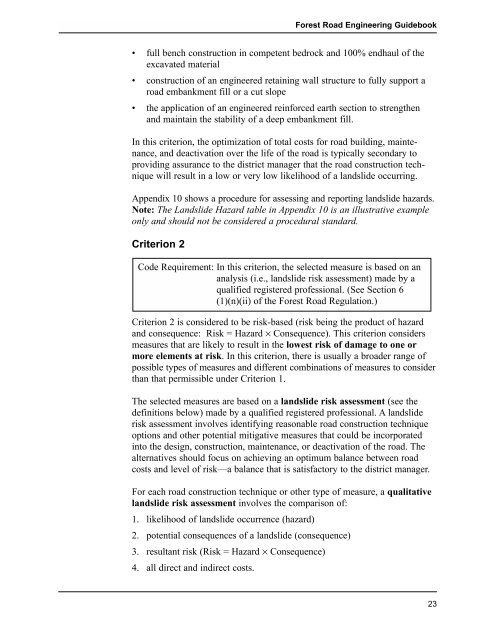Forest Road Engineering Guidebook - Ministry of Forests
Forest Road Engineering Guidebook - Ministry of Forests
Forest Road Engineering Guidebook - Ministry of Forests
Create successful ePaper yourself
Turn your PDF publications into a flip-book with our unique Google optimized e-Paper software.
• full bench construction in competent bedrock and 100% endhaul <strong>of</strong> the<br />
excavated material<br />
• construction <strong>of</strong> an engineered retaining wall structure to fully support a<br />
road embankment fill or a cut slope<br />
• the application <strong>of</strong> an engineered reinforced earth section to strengthen<br />
and maintain the stability <strong>of</strong> a deep embankment fill.<br />
In this criterion, the optimization <strong>of</strong> total costs for road building, maintenance,<br />
and deactivation over the life <strong>of</strong> the road is typically secondary to<br />
providing assurance to the district manager that the road construction technique<br />
will result in a low or very low likelihood <strong>of</strong> a landslide occurring.<br />
Appendix 10 shows a procedure for assessing and reporting landslide hazards.<br />
Note: The Landslide Hazard table in Appendix 10 is an illustrative example<br />
only and should not be considered a procedural standard.<br />
Criterion 2<br />
<strong>Forest</strong> <strong>Road</strong> <strong>Engineering</strong> <strong>Guidebook</strong><br />
Code Requirement: In this criterion, the selected measure is based on an<br />
analysis (i.e., landslide risk assessment) made by a<br />
qualified registered pr<strong>of</strong>essional. (See Section 6<br />
(1)(n)(ii) <strong>of</strong> the <strong>Forest</strong> <strong>Road</strong> Regulation.)<br />
Criterion 2 is considered to be risk-based (risk being the product <strong>of</strong> hazard<br />
and consequence: Risk = Hazard × Consequence). This criterion considers<br />
measures that are likely to result in the lowest risk <strong>of</strong> damage to one or<br />
more elements at risk. In this criterion, there is usually a broader range <strong>of</strong><br />
possible types <strong>of</strong> measures and different combinations <strong>of</strong> measures to consider<br />
than that permissible under Criterion 1.<br />
The selected measures are based on a landslide risk assessment (see the<br />
definitions below) made by a qualified registered pr<strong>of</strong>essional. A landslide<br />
risk assessment involves identifying reasonable road construction technique<br />
options and other potential mitigative measures that could be incorporated<br />
into the design, construction, maintenance, or deactivation <strong>of</strong> the road. The<br />
alternatives should focus on achieving an optimum balance between road<br />
costs and level <strong>of</strong> risk—a balance that is satisfactory to the district manager.<br />
For each road construction technique or other type <strong>of</strong> measure, a qualitative<br />
landslide risk assessment involves the comparison <strong>of</strong>:<br />
1. likelihood <strong>of</strong> landslide occurrence (hazard)<br />
2. potential consequences <strong>of</strong> a landslide (consequence)<br />
3. resultant risk (Risk = Hazard × Consequence)<br />
4. all direct and indirect costs.<br />
23

















